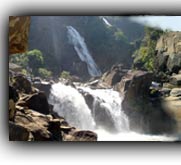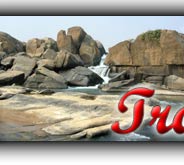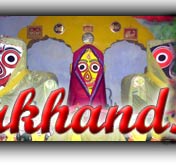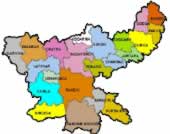 |
 |
 |
 |
 |
- Welcome
- Search TravelJharkhand.com
 Jharkhand, a state of India, is divided into twenty-four districts at present. A district of an Indian state is an administrative geographical unit, headed by a district magistrate or a deputy commissioner, an officer belonging to the Indian Administrative Service. Every district of Jharkhand is headed by a Deputy Commissioner who is over all in-charge of the administration in the particular district. moviesmalayalam. Ranchi, the capital of Jharkhand, is one of the oldest districts in the state. Dhanbad, Bokaro, Jamshedpur, Hazaribagh etc are other important cities in the state.
Jharkhand, a state of India, is divided into twenty-four districts at present. A district of an Indian state is an administrative geographical unit, headed by a district magistrate or a deputy commissioner, an officer belonging to the Indian Administrative Service. Every district of Jharkhand is headed by a Deputy Commissioner who is over all in-charge of the administration in the particular district. moviesmalayalam. Ranchi, the capital of Jharkhand, is one of the oldest districts in the state. Dhanbad, Bokaro, Jamshedpur, Hazaribagh etc are other important cities in the state.
Jharkhand was formed with 18 districts, which were formerly part of south Bihar, back in November 15, 2000. Some of these districts were reorganized to form 6 new districts, in which Khunti is the newly formed 24th district of Jharkhand which came into existance on September 2007. The 24 districts are: Ranchi, Lohardaga, Gumla, Simdega, Palamu, Latehar, Garhwa, West Singhbhum, Seraikela Kharsawan, East Singhbhum, Dumka, Jamtara, Sahebganj, Pakur, Godda, Hazaribagh, Chatra, Koderma, Giridih, Dhanbad, Bokaro, Deoghar, Khunti and Ramgarh.
Maps >>Road, Rail, Physical and Political maps of Jharkhand and its districts
 Ranchi, Capital of Jharkhand is one of the oldest districts in Jharkhand. Ranchi is also called as city of Water falls and lakes. Earlier the name of the district was Lohardaga. The old district had come into existence after the creation of the non-regulation South � West frontier as a result of the Kol rising in 1831-32. The name of the district was changed in 1899 from Lohardaga to Ranchi after the name of a small village now comprised within the headquarters station.......
Ranchi, Capital of Jharkhand is one of the oldest districts in Jharkhand. Ranchi is also called as city of Water falls and lakes. Earlier the name of the district was Lohardaga. The old district had come into existence after the creation of the non-regulation South � West frontier as a result of the Kol rising in 1831-32. The name of the district was changed in 1899 from Lohardaga to Ranchi after the name of a small village now comprised within the headquarters station....... Dhanbad district situated in the state of Jharkhand is a mining and industrial town. It is the largest city in Jharkhand and is famous for its coal fields.Dhanbad is also known as the 'Coal capital' and 'City of Coal' due to the rich deposits present in the district.Dhanbad is about 500-1000 feet above sea level. Its soil is mostly lateritic in nature. The rivers flowing through Dhanbad district are Damodar, Mayurakshi, barakar, Koyal, sankh, Son, Auranga, More, Karo, Bansloi, South Koel, Kharkai, Swarna Rekha.......
Dhanbad district situated in the state of Jharkhand is a mining and industrial town. It is the largest city in Jharkhand and is famous for its coal fields.Dhanbad is also known as the 'Coal capital' and 'City of Coal' due to the rich deposits present in the district.Dhanbad is about 500-1000 feet above sea level. Its soil is mostly lateritic in nature. The rivers flowing through Dhanbad district are Damodar, Mayurakshi, barakar, Koyal, sankh, Son, Auranga, More, Karo, Bansloi, South Koel, Kharkai, Swarna Rekha....... Deoghar is an ancient town situated in the Santhal Parganas of Jharkhand. Deoghar is a famous health resort and a major Hindu pilgrimage center. Baidyanath Temple in Deoghar holds one of the twelve 'Shiva Jyothirlingams' and is also one of the 51 saktipeeths.Places of interest in/around Deoghar include The Chandrakoopa Well, Nandan Pahar, Basukinath, Mandar Hills (69 km from Deoghar, believed to have been used by the Gods to churn Oceans), Satsanga Ashram, Naulakha Mandir......
Deoghar is an ancient town situated in the Santhal Parganas of Jharkhand. Deoghar is a famous health resort and a major Hindu pilgrimage center. Baidyanath Temple in Deoghar holds one of the twelve 'Shiva Jyothirlingams' and is also one of the 51 saktipeeths.Places of interest in/around Deoghar include The Chandrakoopa Well, Nandan Pahar, Basukinath, Mandar Hills (69 km from Deoghar, believed to have been used by the Gods to churn Oceans), Satsanga Ashram, Naulakha Mandir...... The district of Palamu lies between 23�50' and 24�8' north latitude and between 83�55' and 84�30' east longitude. Daltonganj, situated on the North Koel river is the district headquarters of Palamu. The Palamu district is home to the famous 'Palamau National Park' known for its wild life. The park is spread over a core area of 250 square kilometers.Palamu fort is also an important spot tourists must see. Most interesting of all is the massive and beautifully carved stone gate.......
The district of Palamu lies between 23�50' and 24�8' north latitude and between 83�55' and 84�30' east longitude. Daltonganj, situated on the North Koel river is the district headquarters of Palamu. The Palamu district is home to the famous 'Palamau National Park' known for its wild life. The park is spread over a core area of 250 square kilometers.Palamu fort is also an important spot tourists must see. Most interesting of all is the massive and beautifully carved stone gate....... The District Bokaro of Jharkhand State was created in the year 1991 by carving out one subdivision consisting of two blocks from Dhanbad District and six blocks from Giridih District. Bokaro Steel City is the district headquarters of the Bokaro district. It is 47 km from Dhanhad along the Dhanbad-Ranchi Highway. Bokaro Steel Plant is the fourth integrated steel plant in the Public Sector.Places of tourist interest in steel city include Bokaro Steel Plant, Damodar River, Garga Dam, .......
The District Bokaro of Jharkhand State was created in the year 1991 by carving out one subdivision consisting of two blocks from Dhanbad District and six blocks from Giridih District. Bokaro Steel City is the district headquarters of the Bokaro district. It is 47 km from Dhanhad along the Dhanbad-Ranchi Highway. Bokaro Steel Plant is the fourth integrated steel plant in the Public Sector.Places of tourist interest in steel city include Bokaro Steel Plant, Damodar River, Garga Dam, ....... Hazaribagh is one of the twenty-four districts of Jharkhand state. Hazaribagh town is the district capital. Hazaribagh district is named after its capital, the town of Hazaribagh.Hazaribagh is one of the major tourist attractions of Jharkhand.Main tourist attractions in and around Harzaribagh includes Rajrappa Temple, Narshigh Temple, Harihar Dham, Hazaribagh National Park, Telaiya Dam, Silwar Temple Kanhari Hill, Salparni, Barso Pani, Barkattha Suraj Kund........
Hazaribagh is one of the twenty-four districts of Jharkhand state. Hazaribagh town is the district capital. Hazaribagh district is named after its capital, the town of Hazaribagh.Hazaribagh is one of the major tourist attractions of Jharkhand.Main tourist attractions in and around Harzaribagh includes Rajrappa Temple, Narshigh Temple, Harihar Dham, Hazaribagh National Park, Telaiya Dam, Silwar Temple Kanhari Hill, Salparni, Barso Pani, Barkattha Suraj Kund........ The district of Latehar came into existence on 4 April 2001. Previously, it was a subdivision of Palamu district of Jharkhand. Latehar town is the headquarters of Latehar district. It is located roughly around 95 km north-west of the state capital, Ranchi. Main tourist attractions in Latehar district include Jhumri Tilaiya, Tilaiya Dam, Urwan Tourist Complex, Dhwajadhari Hill (Pahari), Satagawan Petro falls, Saint Paramhans Baba Tomb, Makamaro Hills, Shaktipeeth Maa Chanchala Devi.......
The district of Latehar came into existence on 4 April 2001. Previously, it was a subdivision of Palamu district of Jharkhand. Latehar town is the headquarters of Latehar district. It is located roughly around 95 km north-west of the state capital, Ranchi. Main tourist attractions in Latehar district include Jhumri Tilaiya, Tilaiya Dam, Urwan Tourist Complex, Dhwajadhari Hill (Pahari), Satagawan Petro falls, Saint Paramhans Baba Tomb, Makamaro Hills, Shaktipeeth Maa Chanchala Devi....... Lohardaga district came into existence after Ranchi was split into three districts namely Ranchi, Lohardagga and Gumla way back in 1983. The district is named after the town of Lohardaga, the administrative headquarters of the district. Lohardaga was given the position of a sub division in 1972 and a district in 1983. In Jain texts there is reference to Lord Mahavir's visit to Lore-a-Yadaga, which means 'river of tears' in Mundari. 'Ain-e-akbari', The famous book on Akbar, also mentions a place called 'Kisma......
Lohardaga district came into existence after Ranchi was split into three districts namely Ranchi, Lohardagga and Gumla way back in 1983. The district is named after the town of Lohardaga, the administrative headquarters of the district. Lohardaga was given the position of a sub division in 1972 and a district in 1983. In Jain texts there is reference to Lord Mahavir's visit to Lore-a-Yadaga, which means 'river of tears' in Mundari. 'Ain-e-akbari', The famous book on Akbar, also mentions a place called 'Kisma...... Gumla district in Jharkhand state is well known for its natural beauty and hill resorts. Gumla town is the administrative headquarters of Gumla District. It is also the main town in Gumla district. It is located 137 km south-west of Ranchi. 'Chhotanagpur ki raani' - Netarhat, a hill station is located in this district. Main tourist attractions in and around Gumla includes Anjan (18 km away from Gumla), Baghmunda (famous for Ajanta caves stone idols), Birsa Munda Agro Park.......
Gumla district in Jharkhand state is well known for its natural beauty and hill resorts. Gumla town is the administrative headquarters of Gumla District. It is also the main town in Gumla district. It is located 137 km south-west of Ranchi. 'Chhotanagpur ki raani' - Netarhat, a hill station is located in this district. Main tourist attractions in and around Gumla includes Anjan (18 km away from Gumla), Baghmunda (famous for Ajanta caves stone idols), Birsa Munda Agro Park....... Simdega district of Jharkhand is carved out from Gumla district on 30 April, 2001. Simdega is located in the south-western part of the state of Jharkhand. The district is close to the capital of Jharkhand, Ranchi and to the Steel city Rourkela, in Orissa. Simdega town is the administrative headquarters of this district. Simdega is surrounded by Gumla district in the North, Khunti and West Singhbhum in the east, Chhattisgarh state in the west and Orissa state in the South. Simdega district comprises...
Simdega district of Jharkhand is carved out from Gumla district on 30 April, 2001. Simdega is located in the south-western part of the state of Jharkhand. The district is close to the capital of Jharkhand, Ranchi and to the Steel city Rourkela, in Orissa. Simdega town is the administrative headquarters of this district. Simdega is surrounded by Gumla district in the North, Khunti and West Singhbhum in the east, Chhattisgarh state in the west and Orissa state in the South. Simdega district comprises... The movement for a separate state of Jharkhand is an odyssey spread over a century which is traced back to the early 1900s, when Jaipal Singh, an Indian Hockey captain and Olympian, suggested the idea of a separate state consisting of the southern districts of Bihar. The idea did not become a reality, however, until August 2, 2000, when the Parliament of India passed the Bihar Reorganization Bill to create the state of Jharkhand, carving 18 districts .......
The movement for a separate state of Jharkhand is an odyssey spread over a century which is traced back to the early 1900s, when Jaipal Singh, an Indian Hockey captain and Olympian, suggested the idea of a separate state consisting of the southern districts of Bihar. The idea did not become a reality, however, until August 2, 2000, when the Parliament of India passed the Bihar Reorganization Bill to create the state of Jharkhand, carving 18 districts ....... Jharkhand has a population of 26.90 million, consisting of 13.86 million males and 13.04 million females. Like most of our states Jharkhand is also a melting pot where people from different parts of the country have come and settled down. The population consists of 28% tribes, 12% Scheduled Castes and 60% others. There are 32 different tribal communities, major one being Santhals, Oraons, Mundas and Hos. Other tribes include Asur, Baiga, Banjara, Bathudi, Bedia, Binjhia, ......
Jharkhand has a population of 26.90 million, consisting of 13.86 million males and 13.04 million females. Like most of our states Jharkhand is also a melting pot where people from different parts of the country have come and settled down. The population consists of 28% tribes, 12% Scheduled Castes and 60% others. There are 32 different tribal communities, major one being Santhals, Oraons, Mundas and Hos. Other tribes include Asur, Baiga, Banjara, Bathudi, Bedia, Binjhia, ...... The movement for a separate state of Jharkhand is an odyssey spread over a century which is traced back to the early 1900s, when Jaipal Singh, an Indian Hockey captain and Olympian, suggested the idea of a separate state consisting of the southern districts of Bihar. The idea did not become a reality, however, until August 2, 2000, when the Parliament of India passed the Bihar Reorganization Bill to create the state of Jharkhand, carving 18 districts .......
The movement for a separate state of Jharkhand is an odyssey spread over a century which is traced back to the early 1900s, when Jaipal Singh, an Indian Hockey captain and Olympian, suggested the idea of a separate state consisting of the southern districts of Bihar. The idea did not become a reality, however, until August 2, 2000, when the Parliament of India passed the Bihar Reorganization Bill to create the state of Jharkhand, carving 18 districts ....... Jharkhand has a population of 26.90 million, consisting of 13.86 million males and 13.04 million females. Like most of our states Jharkhand is also a melting pot where people from different parts of the country have come and settled down. The population consists of 28% tribes, 12% Scheduled Castes and 60% others. There are 32 different tribal communities, major one being Santhals, Oraons, Mundas and Hos. Other tribes include Asur, Baiga, Banjara, Bathudi, Bedia, Binjhia, ......
Jharkhand has a population of 26.90 million, consisting of 13.86 million males and 13.04 million females. Like most of our states Jharkhand is also a melting pot where people from different parts of the country have come and settled down. The population consists of 28% tribes, 12% Scheduled Castes and 60% others. There are 32 different tribal communities, major one being Santhals, Oraons, Mundas and Hos. Other tribes include Asur, Baiga, Banjara, Bathudi, Bedia, Binjhia, ...... The movement for a separate state of Jharkhand is an odyssey spread over a century which is traced back to the early 1900s, when Jaipal Singh, an Indian Hockey captain and Olympian, suggested the idea of a separate state consisting of the southern districts of Bihar. The idea did not become a reality, however, until August 2, 2000, when the Parliament of India passed the Bihar Reorganization Bill to create the state of Jharkhand, carving 18 districts .......
The movement for a separate state of Jharkhand is an odyssey spread over a century which is traced back to the early 1900s, when Jaipal Singh, an Indian Hockey captain and Olympian, suggested the idea of a separate state consisting of the southern districts of Bihar. The idea did not become a reality, however, until August 2, 2000, when the Parliament of India passed the Bihar Reorganization Bill to create the state of Jharkhand, carving 18 districts ....... Jharkhand has a population of 26.90 million, consisting of 13.86 million males and 13.04 million females. Like most of our states Jharkhand is also a melting pot where people from different parts of the country have come and settled down. The population consists of 28% tribes, 12% Scheduled Castes and 60% others. There are 32 different tribal communities, major one being Santhals, Oraons, Mundas and Hos. Other tribes include Asur, Baiga, Banjara, Bathudi, Bedia, Binjhia, ......
Jharkhand has a population of 26.90 million, consisting of 13.86 million males and 13.04 million females. Like most of our states Jharkhand is also a melting pot where people from different parts of the country have come and settled down. The population consists of 28% tribes, 12% Scheduled Castes and 60% others. There are 32 different tribal communities, major one being Santhals, Oraons, Mundas and Hos. Other tribes include Asur, Baiga, Banjara, Bathudi, Bedia, Binjhia, ...... The movement for a separate state of Jharkhand is an odyssey spread over a century which is traced back to the early 1900s, when Jaipal Singh, an Indian Hockey captain and Olympian, suggested the idea of a separate state consisting of the southern districts of Bihar. The idea did not become a reality, however, until August 2, 2000, when the Parliament of India passed the Bihar Reorganization Bill to create the state of Jharkhand, carving 18 districts .......
The movement for a separate state of Jharkhand is an odyssey spread over a century which is traced back to the early 1900s, when Jaipal Singh, an Indian Hockey captain and Olympian, suggested the idea of a separate state consisting of the southern districts of Bihar. The idea did not become a reality, however, until August 2, 2000, when the Parliament of India passed the Bihar Reorganization Bill to create the state of Jharkhand, carving 18 districts ....... Jharkhand has a population of 26.90 million, consisting of 13.86 million males and 13.04 million females. Like most of our states Jharkhand is also a melting pot where people from different parts of the country have come and settled down. The population consists of 28% tribes, 12% Scheduled Castes and 60% others. There are 32 different tribal communities, major one being Santhals, Oraons, Mundas and Hos. Other tribes include Asur, Baiga, Banjara, Bathudi, Bedia, Binjhia, ......
Jharkhand has a population of 26.90 million, consisting of 13.86 million males and 13.04 million females. Like most of our states Jharkhand is also a melting pot where people from different parts of the country have come and settled down. The population consists of 28% tribes, 12% Scheduled Castes and 60% others. There are 32 different tribal communities, major one being Santhals, Oraons, Mundas and Hos. Other tribes include Asur, Baiga, Banjara, Bathudi, Bedia, Binjhia, ...... The movement for a separate state of Jharkhand is an odyssey spread over a century which is traced back to the early 1900s, when Jaipal Singh, an Indian Hockey captain and Olympian, suggested the idea of a separate state consisting of the southern districts of Bihar. The idea did not become a reality, however, until August 2, 2000, when the Parliament of India passed the Bihar Reorganization Bill to create the state of Jharkhand, carving 18 districts .......
The movement for a separate state of Jharkhand is an odyssey spread over a century which is traced back to the early 1900s, when Jaipal Singh, an Indian Hockey captain and Olympian, suggested the idea of a separate state consisting of the southern districts of Bihar. The idea did not become a reality, however, until August 2, 2000, when the Parliament of India passed the Bihar Reorganization Bill to create the state of Jharkhand, carving 18 districts ....... Jharkhand has a population of 26.90 million, consisting of 13.86 million males and 13.04 million females. Like most of our states Jharkhand is also a melting pot where people from different parts of the country have come and settled down. The population consists of 28% tribes, 12% Scheduled Castes and 60% others. There are 32 different tribal communities, major one being Santhals, Oraons, Mundas and Hos. Other tribes include Asur, Baiga, Banjara, Bathudi, Bedia, Binjhia, ......
Jharkhand has a population of 26.90 million, consisting of 13.86 million males and 13.04 million females. Like most of our states Jharkhand is also a melting pot where people from different parts of the country have come and settled down. The population consists of 28% tribes, 12% Scheduled Castes and 60% others. There are 32 different tribal communities, major one being Santhals, Oraons, Mundas and Hos. Other tribes include Asur, Baiga, Banjara, Bathudi, Bedia, Binjhia, ...... The movement for a separate state of Jharkhand is an odyssey spread over a century which is traced back to the early 1900s, when Jaipal Singh, an Indian Hockey captain and Olympian, suggested the idea of a separate state consisting of the southern districts of Bihar. The idea did not become a reality, however, until August 2, 2000, when the Parliament of India passed the Bihar Reorganization Bill to create the state of Jharkhand, carving 18 districts .......
The movement for a separate state of Jharkhand is an odyssey spread over a century which is traced back to the early 1900s, when Jaipal Singh, an Indian Hockey captain and Olympian, suggested the idea of a separate state consisting of the southern districts of Bihar. The idea did not become a reality, however, until August 2, 2000, when the Parliament of India passed the Bihar Reorganization Bill to create the state of Jharkhand, carving 18 districts ....... Jharkhand has a population of 26.90 million, consisting of 13.86 million males and 13.04 million females. Like most of our states Jharkhand is also a melting pot where people from different parts of the country have come and settled down. The population consists of 28% tribes, 12% Scheduled Castes and 60% others. There are 32 different tribal communities, major one being Santhals, Oraons, Mundas and Hos. Other tribes include Asur, Baiga, Banjara, Bathudi, Bedia, Binjhia, ......
Jharkhand has a population of 26.90 million, consisting of 13.86 million males and 13.04 million females. Like most of our states Jharkhand is also a melting pot where people from different parts of the country have come and settled down. The population consists of 28% tribes, 12% Scheduled Castes and 60% others. There are 32 different tribal communities, major one being Santhals, Oraons, Mundas and Hos. Other tribes include Asur, Baiga, Banjara, Bathudi, Bedia, Binjhia, ......Jharkhand's culture is rich and diverse and as a result unique in its very own way. Archeaologists have unearthed pre-Harappan pottery, pre-historic cave paintings and rock-art from various parts of Jharkhand. That hint at ancient, cultured civilizations inhabiting these parts. The intricate woodwork, the pitkar paintings, tribal ornaments, stone carvings, dolls and figurines, masks and baskets, all are pointing towards the cultural wealth of Jharkhand existed even before the ........
Various religious fairs and festivals celebrated in Jharkhand. Barura Sharif, Belgada Mela Simaria, Bhadli Mela Itkhori, Chatra Mela, Kolhaiya Mela Chatra, Kolhua Mela Hunterganj, Kunda Mela Pratappur, Kundri Mela Chatra, Lawalong Mela, Rabda Sharif, Sangat and Tutilawa Mela Simaria are some of the prominent fairs and festivals of Jharkhand. Specific festivals of the tribes are Karma, Manda, Sarhul, Jani shikar, Bandna etc. Sarhul is the spring festival where Sal tree .......
Home Must see spots Hotels Travel Agencies Advertise with us Contact Feed Back Disclaimer COPYRIGHT © 2008 TravelJharkhand.com�� | |� Designed and Developed by GIGISOFT Solutions |